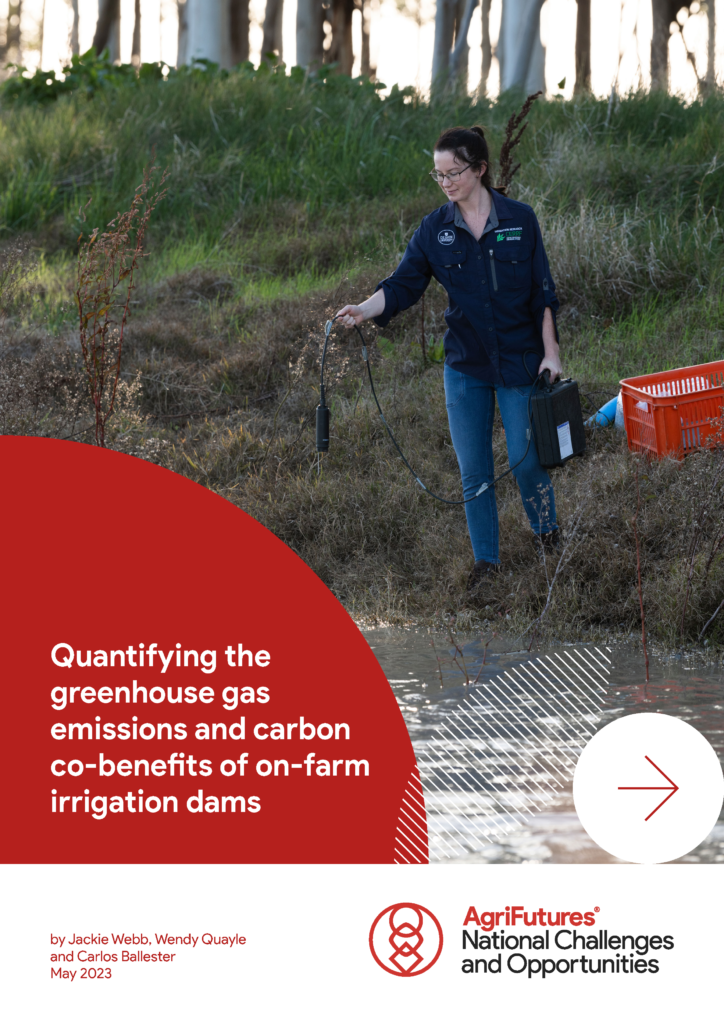Fact sheet: Managing irrigation dams for carbon benefits
Irrigation farm dams help support $8.6 billion worth of irrigated production in the Murray-Darling Basin. These vital water assets on farms can have wetland-like characteristics...
 NATIONAL CHALLENGES AND OPPORTUNITIES
NATIONAL CHALLENGES AND OPPORTUNITIES 
54 pages
Published: 1 Sep 2023
Author(s): Jackie Webb, Wendy Quayle, Carlos Ballester
ISBN: 978-1-76053-414-1
Download report PDF
DownloadPurchase a hard copy - AUD $50
Irrigated agriculture is a widespread practice in Australia vital for ensuring water supply to grow $18.9 billion worth of food, fibre and dairy products. Irrigated agriculture has created high densities of artificial waterbodies, such as farm dams for water storage and channels for water conveyance and drainage. Global studies suggest small artificial waterbodies can be significant sites of emissions of carbon dioxide (CO2) and methane (CH4), and using Intergovernmental Panel on Climate Change (IPCC) rules must be accounted for in national emission inventories. There is, however, limited data and information on this issue in Australia. This study addressed the challenge of reducing greenhouse gas (GHG) emissions and measuring greenhouse gas emissions from these sources.
A survey of 38 on-farm irrigation dams across horticulture and broadacre cropping in the Murrumbidgee Valley of NSW, Australia was used to baseline their carbon footprint and provide insight into areas that should be targeted for emissions management. The comprehensive sampling campaign involved measurement of greenhouse gases, water quality and sediment carbon storage in farm dams, farm dam classification and an aerial drone survey that mapped biomass carbon storage. The survey captured the diversity of farming systems within the Riverina region, with sites located on properties growing cotton, rice, wine grapes, citrus, cereals and canola, as well as mixed cropping with livestock. Farm dams were classified into four dam types to help with analysis: horticultural dams, storage dams, recycle dams and turkey nests.
The goal for in situ carbon dioxide monitoring was to capture the ‘actual’ sink (or source) potential of farm dams by measuring continuously to capture seasonal trends and episodic events, and to compare differences in water management between farm dam types. Biomass surveys were used to map the amount of buffer vegetation in naturally enhanced sites to estimate total biomass carbon stocks. Overall, the majority of irrigation farm dams were acting as absorption sinks for greenhouse gases, with most acting as sources of diffusive methane emissions.
Compared with global averages, the sample irrigation dams had considerably lower methane emissions than the IPCC emission factor (EF) for constructed ponds, and had a lower indirect nitrous oxide EF compared with the IPCC default EF for rivers and lakes. These preliminary findings suggest the IPCC should have a sub-category specifically for irrigated sub-catchments, considering differences in land use, hydrology and productivity compared to non-irrigated agriculture.
Overall, horticultural dams had the lowest carbon footprint, with average carbon dioxide (CO2) emissions of 8.5 g CO2 m-2 season-1 and highest average sediment C storage of 11.8 t ha-1. Recycle dams had up to 24 times higher CO2-equivalent emissions compared to other dam types. The emission difference is likely due to differences in water regime and on-farm management, where recycle dams tend to receive more nutrients, making them eutrophic waterbodies. The results suggest reducing eutrophic conditions in irrigation farm dams could result in 70% less carbon dioxide emissions.
This study estimates methane and nitrous oxide emissions are five and four times lower, respectively, than the global emission factors reported by the IPCC for constructed freshwater ponds and agricultural surface waters. The study identified factors that may enhance farm dam carbon storage and reduce greenhouse gas emissions, which means growers can incorporate new strategies to offset other on-farm emissions. To consider irrigation farm dams in carbon markets, the next steps would be to directly test some of the promising strategies for carbon storage and emission reduction identified in this study and develop the methodology.